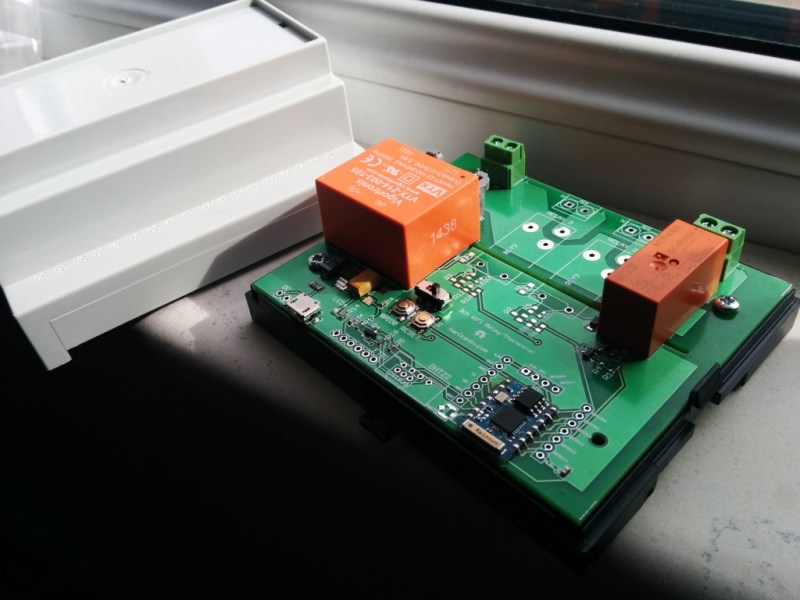If you’ve ever lived in a building with manually controlled central heating, you’ll probably understand [Martin]’s motivation for this hack. These heating systems often have old fashioned valves to control the radiator. No Nest support, no thermostat, just a knob you turn.
To solve this problem, [Martin] built a Wi-Fi enabled thermostat. This impressive build brings together a custom PCB based on the ESP8266 Wi-Fi microcontroller and a mobile-friendly web UI based on the Open Thermostat Scheduler. The project’s web server is fully self-contained on the ESP8266.
To replace that manual value, [Martin] used a thermoelectric actuator from a Swiss company called HERZ. This is driven by a relay, which is controlled by the ESP8266 microcontroller. Based on the schedule and the measured temperature, the actuator lets fluid flow through the radiator and heat the room.
As a bonus, the device supports NTP for getting the time, MQTT for publishing real-time data, and ThingSpeak for logging and graphing historic data. The source code and design files are available under a Creative Commons license.
















Nice job!
This is really COOL… ;^)
+1
Wow, he invented a DC transformer. Give him a Nobel prize!
There are PCB-mount transformers with built-in rectifier.
But there are more design choices that are a bit beyond me. Like the choice of using mechanical relays, citing dissipation as consideration (hardly an issue with a 2.5W load), eliminating the possibility to use the actuator in proportional mode (PID temperature control = extra efficiency). But hey – it’s not my energy bill.
Does it interface to something like Google Calendar. If os that could be really helpful for setting a schedule.
Also some buttions and and an LCD for when you do not want to dig out your cell phone just to turn up the heat.
Is it closed source? I couldn’t find a link to the source code.
I didn’t see any source either. Might be using Lua?
Excellent work and worth evaluating on it’s own merit. Starting with the use of a DIN Rail Box for an ENERGY CONTROLLER- the whole project is beyond crude concept proof and well into entry level commercial. Mechanical Relays are a known quantity with certain known failure modes= SSR’s of “some designs” tend to fail ON. So we’re needfully directed to sanity check those fail modes early in a project and review them often.
That said? There’s a shortlist of absolute criteria for Remote Energy projects to be considered for safety and sanity.
Security is no longer optional on many levels inclusive of overlooked interactions. Is it’s “Radio” a new exploit vector? After Infosec you hit the queries of “what happens if it fails?” So… Fail-Safest logic is likely the tie priority with Security. Always consider that duality in all such projects.
This is a ZONE CONTROLLER and not per se the same risk as a direct burner controller.
But it still CAN cause call-for-heat simply by causing a heat load. If you use anything that can turn a burner or chiller on- you are betting a lot on other people’s designs preventing Very Bad Things caused by your mistakes.
And that is the breakpoint above all others. This project simply actuates a Zone Valve. It cannot cause disaster beyond a hot or cold room. Unless one considers a Hostile Exploit of MANY controllers as a threat…
Was going to make a similar comment regarding the fact it lacks any sort of approval by a national testing laboratory. Should the house burn down (not necessarily due to this device), you can bet the insurance carrier will be looking to dismiss any claim due to the heating system having been tampered with.
Local AHJ may also have something to say about it (most municipalities require a UL listed devices in order to issue a CO, and you can bet the insurance carrier will be equally as dilligent).
But hey, his risk evaluation. If it were me, no way would i be screwing around with a ‘wifi’ thermostat… totally insane.
I can’t get a good feel for the exact spacing, but the cut board between low-voltage and wall-AC sections looks good.
Herz si an Austrian company not Swiss. Herz Armaturen.
Martin said “swiss made” and someone translated English to English swiss made = swiss company.